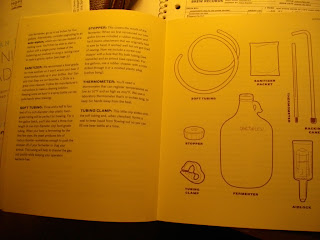And toward the end of my undergraduate career I met guys who brewed their own beer.
Their own beer!
Brewed at home!
I knew how to cook and bake, but never considered beer was something you could do at home. Although I was aware of the basics of the history of beer at that time, and I knew it wasn't always brewed in massive technologically advanced factories, but at times by monks, bootleggers, ancient slave-based economies, and American patriots, I didn't know I could do it on my own in my own kitchen. As my knowledge of home craft brewing grew I became disheartened to learn that to brew at home I'd have to brew in 5-gallon batches, which, in my 4th floor walk-up, was a bit daunting. Friends from college got into brewing and I grew jealous because they were doing what I wanted to do, but didn't have the money or full motivation to get into. One old roommate has even brought beer into his career writing for a beer magazine and currently doing research for a book on craft brewing across the country. Then I found this book:
I've mentioned it before and want to give a fuller "review" of it in this entry.
Last fall I was looking at homebrewing books at Amazon and came across this one put out by the Brooklyn BrewShop. I'm not sure if I knew it at the time, but this book is aimed at brewing beer in 1-gallon batches. I put it my wish list and my folks bought it for me for Christmas. What joy! My folks have always been oddly supportive of my beer habit, even buying me a coffee table book on beer (likely a future review) and a beer mug keychain when I was still underaged. I started reading the book soon after Christmas and discovered the world of 1-gallon homebrewing. By the end of January I bought a homebrewing kit and was ready to brew my own beer.
Written by hipster Brooklynites Erica Shea and Stephen Valand, the Beer Making Book's authors share their experience of living in a closet in the greatest city in the world (well, one of it's boroughs) and brewing beer in their own kitchen instead of having to pay $8/beer going out to a bar. (Doing the math you will find homebrewing is not a cost effective replacement for store bought or going out to a bar. It's for the joy of it.) The recipes call for spices and hops that someone living in NYC would have no problem attaining with just an afternoon of subway riding, but for someone living in Cleveland, Ohio, these recipes can prove slightly challenging to reproduce exactly. That's ok, though, because spontaneous substitution and quick goat-thinking makes cooking fun and interesting!
I kid and mock because hipsters are a target for my cynicism, but this book is good for beginners. However, I like a little more depth when I'm learning about something new and this book lacks that. There are brief introductory sections on the history of brewing,
beer ingredients, equipment for homebrewing (which they sell individually or in kits on their website and at local stores),
how to brew, and then a series of 52 recipes divided into the four seasons of the year, as well as food recipes that use the beer you've just made (or the grain you've steeped). These recipes all follow the same pattern, and reiterate the same material about mashing and sparging in each recipe. After further reading from another more thorough book, I have found these recipes to be good bases but not enough for a well rounded guide through the joy of brewing, at least for me and my way of thinking.
Case in point: If you brew from all grain, eschewing dry or syrup malt extract, the first step is bringing a certain amount of water to a certain temperature around 160F, then adding the milled grains and turning off the heat. The grains are then to steep for an hour and you are to make sure the mash (grains+hot water) stays around 155-160F. But what if it's too hot? This book suggests adding 1 C cold water and stirring, bringing the temperature down to the desired range. But what if it gets too cold? This book suggests you turn the heat back on and stir until the mash is again at the right temperature. These are both good things and helpful to know when brewing. However, every recipe in this book reiterates the "what if too cold" scenario, but not the "what if too hot," and when that happened to me during my first two batches I thought I screwed it all up. After the second batch I reread the intro section on how to brew and saw the steps on what to do if the mash gets too hot and now have it committed to memory, but it seems arbitrary to include the rescue out of one scenario but not the other.
I'm not saying this isn't a good book. It opened my eyes to homebrewing in small batches (nanobrewing) and gives me good recipes from which I can now experiment with, knowledgeably making substitutions and additions to tailor the final product to my desires. And I've happily suggested it to friends who are interested in homebrewing. But if I were their editor I would have suggested a few more clarifications, and toned down the foo-foo nature of some of the recipes. (Lobster Saison, seriously?)
Next book review will be on Beer Craft by William Bostwick (relation to actor Barry?) and Jessi Rymill. Now this one is a good introduction to homebrewing.
What was your introduction to homebrewing? Did you use a book or have a favorite one that you follow religiously?
Until next time friends, happy brewing!




No comments:
Post a Comment